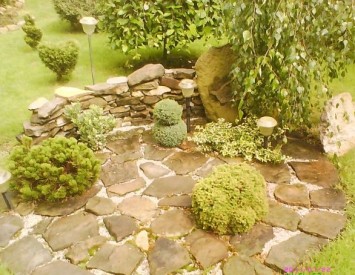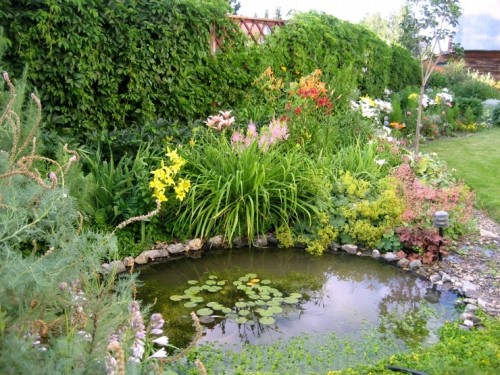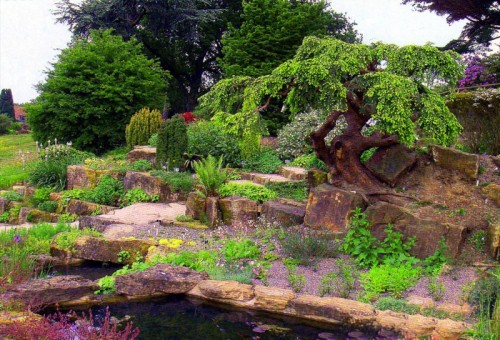As a result of climatic changes or increasing the level of groundwater, flooding or searing of the land plot occurs. There are several methods of how to drain the swamp in the summer cottage. As a result of such works, in a very small territory, a violation of the ecological balance is reduced, so the question of whether it is necessary to drain the swamp on your site.
Content
Those arguments that cannot be drained by swamps do not withstand critics. On your land plot, this is simply necessary to do this. Of course, this is a time -consuming and costly process, but nothing is impossible. The work begins with geological and geodetic studies of the soil, which will give a conclusion about the causes of swamping, methods of drainage and whether it is necessary to drain the swamp in this place.
Ways to drain the swampy site
An effective drainage system will allow you to take excess water from the land and set the necessary level of moisture for successful agriculture. There are three main methods of draining the site and each of them has its own advantages and disadvantages.
- The open method consists in laying network channels along the site. Conventional and gross channels are interconnected and fixated to the main channel. The central main channel, plays the main role of the drainage and leads to the water intake outside the site.
- The closed method consists in laying the drainage system. Such work requires the correct layout and discord, cast iron, asbestos or plastic pipes are used for the drainage system. Now they produce plastic corrugated pipes with a winding of geotextiles of different diameters.
- The combined method combines the first two and is very popular in summer cottages. Dense clay soils can contribute to swamping. In such cases, you can make a selection of heavy soil to the level of groundwater and make a bulk plot of loose soil of a suitable composition.
- There are other non -standard methods for solving this problem. You can completely choose heavy soil and fill up the place with fertile soil. If you are not interested in agriculture, then you can create an artificial lake by deepening the swampy area.
Preparatory work and open method of draining the swampy area
What method of draining the swamp is suitable for your site can only be said after clarifying the causes of swamping. For this, a study of the site in the swamp is carried out. Soil samples are taken, groundwater levels are set, the direction of the drain along the ground layers and the lower point of the relief.
- As a result of research by the geological and geodetic service, you must get a three-dimensional plan of the site and have a clear idea of \u200b\u200bthe direction of movement and the depth of groundwater. Outside of the swampy area, determine the place for the drainage well. It should be located at the lowest point and sufficient depth.
- For the middle site, a well is suitable for a diameter of about a meter. It rummages or drills to groundwater. The bottom is covered with gravel, with a thickness of 30 cm to half a meter. The walls can be strengthened with brick masonry or set of concrete pipes of the corresponding diameter. You can also equip an artificial reservoir in the lowest current of the summer cottage, and use the collected water for watering the site.
- From the well, draw a straight line to the very top point of the land. The main trench for flowing water will run along it. A trench of 50x75 cm, the bottom of which is covered with a mixture of sand and crushed stone, can approach the average swampy area for a medium swampy area, and it is well crushed. The walls of the trench can also be strengthened with brick masonry or pick up improvised materials. For example: cutting of boards, sheet metal or slate and fix them along the walls of trench stakes. The slope from the upper point of the trench to the lower- the place of drainage of the drainage trench into the well should be 25 °- 30 °.
- Perpendicular ditches are made less deep and especially not strengthened. Depending on the state of swampy, they can be deepened, expanded and added to new ones. All side ditches converge to the central trench under the slope. The smaller the water area, the more difficult it is to leave. Therefore, ditches must be periodically cleaned and deepened.
Hidden drainage systems of drainage of swampy soil
Drands are special pipes for draining the swampy land. Up to 50% of the upper part of the pipe is covered with holes for water intake. The holes are equipped with mesh filters, or a winding is made by geotextile fabric to prevent clinging and blockage of drainage drainage pipes.
- Pipes are used of different diameters and material. Of the new products, there are corrugated pipes that have the ability to correspond to embossed contours and have smooth internal surfaces. Concrete, asbestos, plastic and other pipes of suitable diameter are also used. The holes can be inhabited in such pipes yourself, and it is not difficult to stick mesh filters on waterproof silicone.
- In accordance with the three -dimensional plan, trenches are torn off. The central highway is laid, as deep as possible with the optimal ramp of 30 ° and the diameter of the pipe from 100 to 150 mm. Radial and perpendicular bends, with pipes diameter of 50 - 75 mm or to a inch - one and a half, are hung on the main pipe.
- The trench with dimensions of 50x100 cm is preliminarily covered with a sand and gravel mixture and is well crushed. Hexotextiles are laid, drainage pipes are laid, the space is covered with crushed stone and covered with hexotexts. The trench is covered with fertile soil.
Combined drainage systems and non -standard methods of drainage of swamps
The third method is combined to combine the first two methods of drainage of swamps. Most often, this method is used in summer cottages.
- As a rule, the main central highway is made underground - the main drainage pipe is laid, into which excess water flows along the ditches. The installation and laying technology of the drainage pipe is standard. Summary of waste ditches - described above in the paragraph about the open method of the withdrawal of groundwater when closing the land.
- Severe and clay soils often cause a swamp on the site. The radical and effective method of solving this problem is to remove clay soil. In the designated area, the loam breed is removed to the groundwater horizon. The bottom of the dug pond is covered with sand and gravel, trim in order to serve in the future drainage.
- The question of how to fall asleep the swamp on the site depends on what you are going to grow on it. Dense and fatty chernozems can be diluted with peat mixtures or calcium sands. Fruit trees on waterlogged soils grow poorly, so pick up moisture -loving shrubs or melons.
The original method of eliminating the swamp on the site will be converted it into an artificial pond. It is only required to deepen the territory, strengthen the shores of the artificial lake and ennoble the surrounding area. Moogal -loving, weaving willow, fern, Irga, hawthorn or Amur lilac will look beautiful along the shores. The tables and benches will complement a cozy natural corner. For perfect harmony, you can turn to landscape design specialists.














